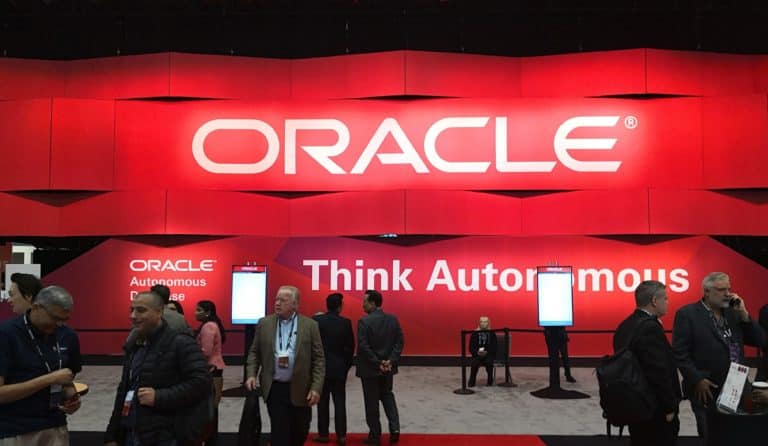Enterprises increasingly look to the public cloud for their applications and data. Oracle provides a complete stack for this with its cloud environment. By opening more Generation 2 (‘Gen 2’) Cloud data centers, this will certainly help customers embrace the public cloud. Next stop is Amsterdam, where Gen 2 is now available.
Oracle believes that in today’s world in which data is becoming increasingly important, companies cannot escape embracing the public cloud. That’s what Andrew Sutherland, senior vice president systems & technology EMEA and APAC at Oracle, discussed with Techzine.
Moving to the public cloud is not an easy thing to do, and comes with certain limitations. What about flexibility and scalability and how to keep costs down? How do companies incorporate the data of others, and how do they get added value from it? These are all questions that arise when enterprises want to use the public cloud.

Development of Oracle Cloud Gen 2 Cloud region
Oracle decided to incorporate all these questions into a complete redesign of its public cloud, says Sutherland. To offer customers the tools to use their important applications and data for innovation. Also, Oracle wants to show that, as a traditional specialist in the field of on-premise solutions, it can also offer its services in a public cloud.
Combination of IaaS, SaaS, PaaS and ecosystem
Oracle created a full-stack public cloud; the Oracle Gen 2 Cloud. The version does not only consist of various products and services that are built in the cloud but consists of an entire framework.
If we take a closer look at this framework, which is to be fully implemented by the end of 2020, Oracle will have 36 Gen 2 data centers worldwide. Oracle’s cloud offering consists of various IaaS, SaaS and PaaS layers. The basis of the public cloud is formed by services such as compute, storage, networking, security and governance. This forms the IaaS platform of the Oracle Cloud Infrastructure.
On top of that are the PaaS and SaaS services. Under PaaS services falls the well-known Oracle Data Warehouse (database) and the cloud-based Exadata databases. Under SaaS services, you can think of ERP, HCM and Customer Experience (CX) tools.
In addition to off-the-shelf services, there are building blocks to create your own innovations in the Oracle Cloud. Think of tools and services for DevOps, Big Data & Analytics, a container ecosystem and hybrid services.
This entire stack is complemented with an ecosystem of partners that provide related services and have interoperability. These are, for example, solutions from Fortinet, Palo Alto Networks, Microsoft and VMware. More about these last two later.
Other technology for Oracle Gen 2 Cloud
Oracle Gen 2 Cloud uses a lot of automation. Or as Oracle itself calls it: Autonomous. This is visible in the compute stack of Oracle Cloud Infrastructure with the recent introduction of OS Autonomous Linux. In the PaaS layer there is the automated database; Autonomous Data Warehouse.
On top of that, a dose of artificial intelligence (AI) and analytics is added. Sutherland talks about the advantages of AI in the various SaaS applications. He also indicates how analytics will help customers of the Autonomous Data Warehouse, a fully automated database, to process large amounts of data faster and use the results for innovation or growth of the business.
With this full public cloud stack, customers can get to work to take their business to the next level, simplify it and innovate.
The tech company points out that customers are not obliged to buy everything from the cloud or move it to the cloud. They can still use applications on-premise or only partially purchase services from the cloud. Should they still want a ‘one stop shop’, Oracle will make this possible within its Gen 2 Cloud.
Oracle Cloud Infrastructure remains the most important foundation
Within the Oracle Gen 2 Cloud, the Oracle Cloud Infrastructure or the IaaS layer remains the most important, Sutherland shows. This layer should offer customers higher performance for all applications and data and more flexibility. The latter because they always need to be able to adjust or change certain actions and the use of the public cloud. Especially when certain actions can interfere with or harm other processes within the company.

Improved monitoring and security
The Oracle Cloud Infrastructure must also provide more governance. This means more visibility, control, and service level management capabilities. More comprehensive monitoring functionality to keep an eye on everything.
Security is important as well. In the Oracle Cloud Infrastructure layer, the Oracle Gen 2 Cloud now has comprehensive security solutions and applications. All individual components of the public cloud platform are now available at different security levels. Oracle guarantees that the infrastructure is completely separate from the control plane. So there are no Oracle agents on the (compute) hardware of customers.
Better migrations
Another important feature is that customers with Oracle Cloud Infrastructure can now more easily migrate and run workloads wherever they are. This is especially useful when it comes to maintaining legacy systems or applications. When using Oracle Gen 2 Cloud these must be able to continue to function and run normally. Sutherland prefers to talk about ‘heritage’ systems or applications.
He repeats that Oracle does not want enterprises to be forced to switch to the public cloud, they need to make this choice themselves. Mainly because they still want to profit from their earlier investments or because some applications and workloads cannot be brought to the cloud. For example, because of legislation and regulations. It should technically be possible to accommodate everything in the Oracle cloud.
Take a ‘pizza slice’ of Oracle cloud on-premise
Enterprises that want to benefit from Oracle Gen 2 Cloud but do not want to move everything into the public cloud, can purchase a ‘slice’ from Oracle’s public cloud. They get an Oracle-machine in their own data center. This ‘cloud machine’ is owned and managed by Oracle as an extension of the public cloud. Customers can still purchase all the desired services provided by Oracle Gen 2 Cloud, but run it on-premise in their own data center. Another advantage of this ‘pizza slice approach’ is that customers can enjoy minimal latency.
Interoperability between environments
The technology company wants to ensure that enterprises can use multiple environments. Most enterprises have adopted a multi-cloud strategy. This requires interoperability and access to multiple hybrid and public clouds.
Oracle has an extensive partnership with Microsoft Azure. This collaboration consists of interconnection and service agreements between both parties. Customers working with both environments can easily connect the workloads and data of both cloud environments.
Oracle also has a partnership with VMware. This partnership allows customers to migrate existing VMware environments and architectures to the Oracle Gen 2 Cloud. These can be managed as if they are still on-premise at the customer, or in VMware’s cloud environment.

Not just lift-and-shift
Sutherland emphasizes that Oracle Gen 2 Cloud is not only intended for the lift-and-shift of applications and workloads, especially those of legacy systems between all different environments.
Oracle’s public cloud not only brings applications and workloads to the cloud, it also helps develop new applications quickly and efficiently. They can also be improved and developed entirely ‘cloud native’, for example with the Kubernetes orchestration services and serverless functions.
Expansion of number of cloud regions
To make it even easier for enterprises worldwide to acquire Oracle Gen 2 Cloud, Oracle is rapidly expanding its regional presence or ‘cloud regions’ with new data centers. A total of 20 new cloud data centers are involved. These should bring the global total to 36 cloud data centers by the end of 2020. Several of these data centers will also form ‘interconnection hubs’ with Microsoft’s Azure data centers.
Dutch customers mainly used the cloud data center in Frankfurt up till now, which results in some latency. With the arrival of the cloud region in Amsterdam, this is a thing of the past.
Oracle Gen 2 Cloud region Amsterdam
One of these new Gen 2 Cloud data centers is now live in Amsterdam. this makes it easier for Dutch customers to purchase Oracle services and to have their data close by. Country Leader Wilfred Scholman of Oracle Netherlands told us that this improves the latency for a lot of customers. Dutch customers mainly used the cloud data center in Frankfurt up till now, which results in some latency. With the arrival of the cloud region in Amsterdam, this is a thing of the past.
Another important advantage of the Amsterdam cloud data center is that it is the third Oracle data center in the European region. In addition to Frankfurt, there is also one in London. Due to Brexit, Amsterdam will become the second location within the EU zone. Companies and sectors that have to comply with a lot of European legislation and regulations will also be able to go there. The Amsterdam cloud data center will also have an interconnect for Microsoft Azure in the (near) future.
Smart move
Oracle creates a broad cloud offering in the busy public cloud landscape. One stop shop is possible, but not mandatory.
Oracle not only found a way to do public cloud, on-premise and hybrid cloud with their ‘pizza slice’ approach, they also found a way to do multi-cloud by partnering with Microsoft Azure and Vmware. This can be a stepping stone for customers to order more services from Oracle. We are curious to see if this will help Oracle gain a larger part of the public cloud. Techzine continues to follow it with great interest.
